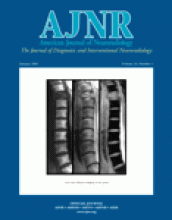To the Editor: The article by Villablanca et al (1) in the August 2002 issue of the AJNR presents an interesting study, but the results do not support the conclusion that the sensitivity of CT angiography is higher than that of digital subtraction angiography for the detection of cerebral aneurysms ≤5 mm. A significant problem with the study is that the CT angiograms and digital subtraction angiograms were not obtained on the same day. In the two cases of “false-negative” results of digital subtraction angiography, the CT angiograms were obtained 2 and 5 days after the digital subtraction angiograms were obtained. Both of these patients had suffered subarachnoid hemorrhage, and it is possible that these two aneurysms were filled with thrombus at the time of digital subtraction angiography but not at the time of CT angiography. It is well known that subsequent angiograms reveal a source of subarachnoid hemorrhage in 2% to 24% of patients with initially negative angiographic results (2). Repeat digital subtraction angiography performed on the day the CT angiograms were obtained probably would have also revealed the aneurysms. Also, if CT angiography had been the initial study and digital subtraction angiography had been performed later, then the aneurysms would likely have been missed by CT angiography and revealed by digital subtraction angiography.
Even if we accept the sensitivities reported as correct, the patient population used was too small to support the conclusion that CT angiography is more sensitive than digital subtraction angiography. For CT angiography, the sensitivity was 98% (95% confidence interval, 87% to 100%) for reader 1 and was 100% (95% confidence interval, 91% to 100%) for reader 2. For reasons that are unclear, the authors did not report a 95% confidence interval for the digital subtraction angiographic results. For digital subtraction angiography, the sensitivity was 95%, and we calculate the 95% confidence interval to be 84% to 99%. By definition, these confidence intervals tell us that there is a 95% certainty that the true sensitivity is within the interval. Note the tremendous overlap in the 95% confidence intervals, indicating that it is not possible to distinguish a difference in sensitivity. The P values for the difference in sensitivity between CT angiography and digital subtraction angiography based on the data provided are P = .56 for reader 1 and P = .15 for reader 2. Table 1 of the article by Villablanca et al (1) indicates that patient 22 also had an aneurysm missed by CT angiography, but this missed aneurysm was not included in the data analysis. If Table 1 is correct, then the sensitivity of CT angiography would be even lower.
Maximizing sensitivity for the detection of ruptured cerebral aneurysms is critical for optimal patient care. The missed diagnosis of a ruptured cerebral aneurysm can have devastating consequences. The risk of rebleeding from a ruptured aneurysm without surgery or endovascular treatment is between 20% and 30% for the first month after hemorrhage (3). Patients who rebleed from ruptured aneurysms have an 80% mortality rate (4). The risk of permanent neurologic complication associated with cerebral angiography in patients with subarachnoid hemorrhage, cerebral aneurysm, and arteriovenous malformation is known to be extremely low (0.07%), based on a meta-analysis of recent, prospective studies (5). The neurologic deficits complicating angiography tend to be much less severe than the morbidity and mortality caused by rebleeding of a ruptured aneurysm.
CT angiography is undoubtedly a promising technique for the detection of cerebral aneurysms, and the sensitivity of CT angiography is probably now beginning to approach that of digital subtraction angiography. CT angiography can already serve as a useful adjunct to digital subtraction angiography in cases of angiogram-negative subarachnoid hemorrhage (6). We think that it is premature to consider CT angiography to be a replacement for digital subtraction angiography for the evaluation of patients suspected of harboring cerebral aneurysms. The sensitivity of CT angiography must continue to improve, as the sensitivity of digital subtraction angiography has certainly improved with the development of 3D rotational angiography (7). In addition to the issue of sensitivity, the superior spatial resolution of digital subtraction angiography allows for more definitive treatment planning for patients with cerebral aneurysms. It would be interesting to know whether the authors take the results of their study seriously enough to replace digital subtraction angiography with CT angiography in their practice for patients presenting with subarachnoid hemorrhage.
References
- Copyright © American Society of Neuroradiology












